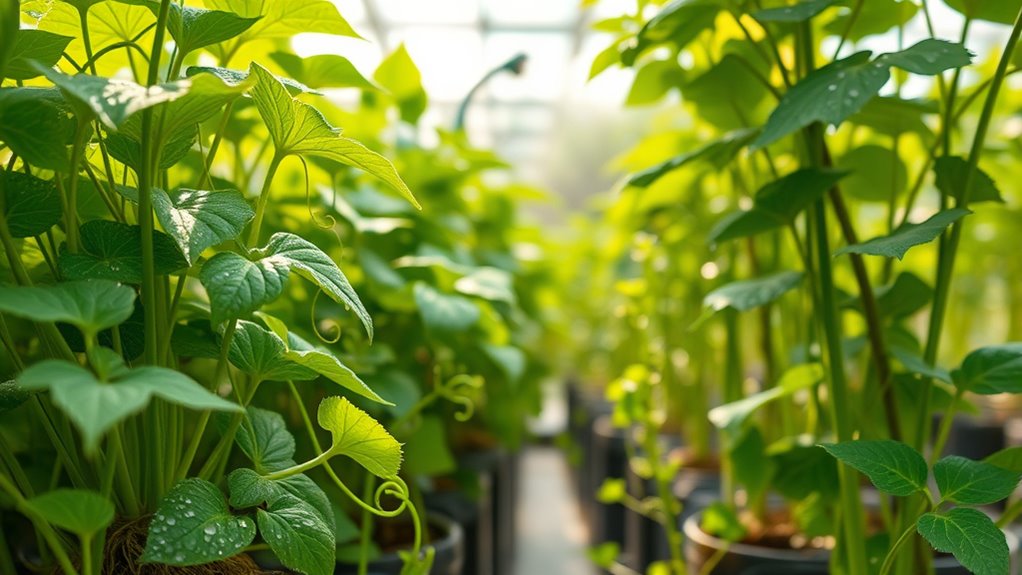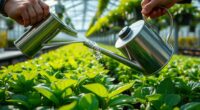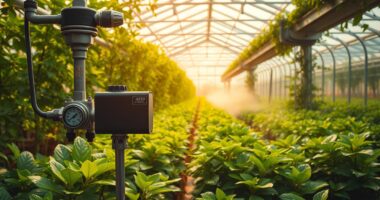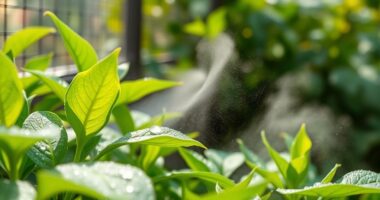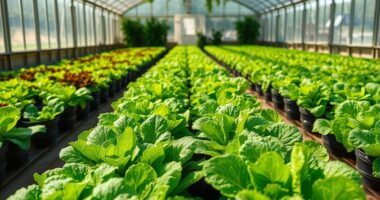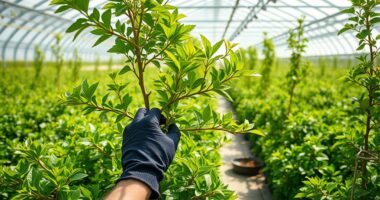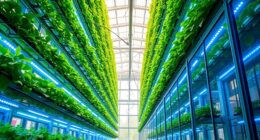To care for your greenhouse plants, focus on proper watering by checking soil moisture and avoiding overwatering. Maintain a stable environment with ideal temperature and humidity using gauges and controls like humidifiers or fans. guarantee good air circulation with ventilation systems and circulation fans. Prevent pests and diseases by encouraging airflow, practicing crop rotation, and inspecting plants regularly. Staying consistent with plant monitoring and adjustments helps keep your greenhouse thriving; discover more tips below.
Key Takeaways
- Maintain proper watering by checking soil moisture and watering gently to prevent over- or under-watering.
- Regulate temperature and humidity with thermostats, humidifiers, and dehumidifiers to create ideal growing conditions.
- Ensure effective ventilation through fans, vents, and proper layout to promote airflow and prevent mold.
- Prevent pests and diseases by promoting good airflow, practicing crop rotation, and inspecting plants regularly.
- Monitor plant health continuously with soil tests and visual checks, adjusting care routines accordingly.
Proper Watering Techniques
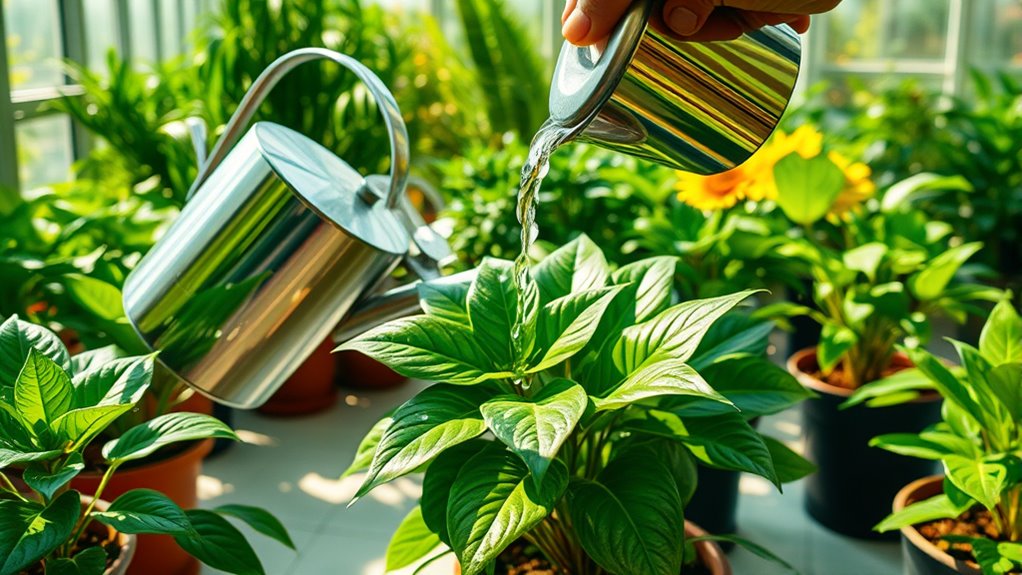
Proper watering is essential for healthy greenhouse plants, and understanding the right techniques can make a significant difference. You need to pay attention to watering frequency to prevent over- or under-watering. Check soil moisture regularly by feeling the top inch of soil; it should be moist but not waterlogged. Water your plants when the soil begins to dry out, typically every few days, but this varies depending on plant type and environmental conditions. Use a gentle stream of water to avoid disturbing roots and ensure even moisture distribution. Consistent watering helps maintain the right soil moisture level, promoting healthy growth and preventing issues like root rot or dehydration. Additionally, maintaining proper indoor air quality can help regulate moisture levels and create a more stable environment for your plants. Proper ventilation with air purifiers can reduce excess humidity and improve air circulation, further supporting healthy plant development. Being mindful of humidity levels can also prevent fungal diseases and promote optimal growth for your greenhouse plants. Incorporating moisture meters can help you monitor soil conditions more precisely and tailor your watering schedule accordingly. Adjust your watering schedule based on your plants’ needs and the indoor climate.
Maintaining Optimal Temperature and Humidity
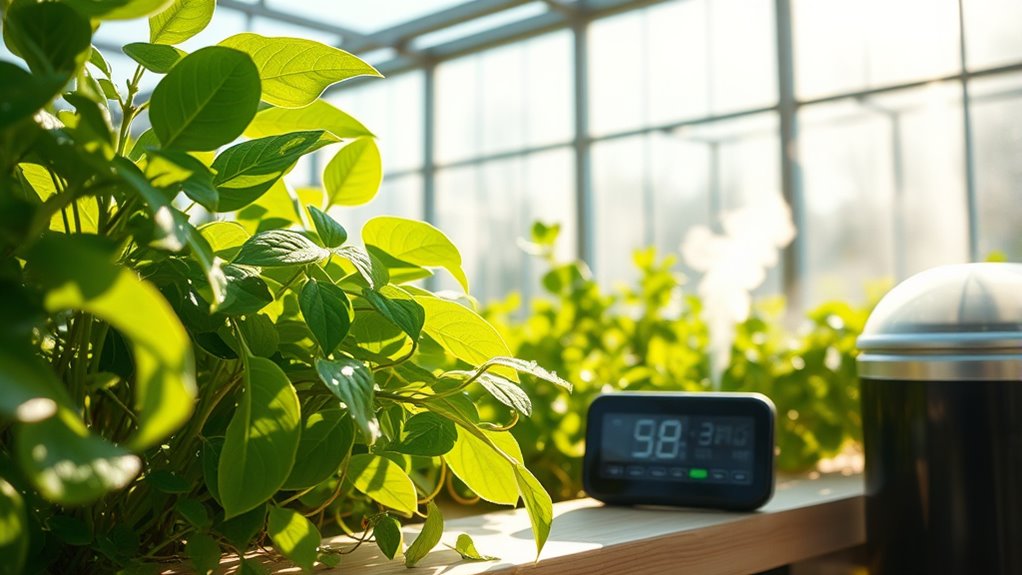
Maintaining the right temperature and humidity levels is essential for healthy greenhouse plants, as fluctuations can stress or damage them. Effective temperature regulation keeps your plants in their ideal range, preventing heat stress or cold damage. Use thermostats and heaters or fans to adjust temperatures quickly. Monitoring signs of spoilage in your environment, such as mold or condensation, can help you identify issues early. Humidity control is equally important; too much moisture can lead to mold, while too little causes dehydration. Use humidifiers or misters to increase humidity, and vent fans or dehumidifiers to reduce it. Regularly monitor both temperature and humidity with reliable gauges, adjusting your systems as needed. Proper insulation and noise reduction technology can also contribute to maintaining stable conditions and minimizing environmental stress. Understanding climate control and its impact on plant health is crucial for optimal growth. Proper management of these factors involves understanding the nutritional value of juices and how environmental conditions affect plant vitality, ensuring a thriving greenhouse environment.
Effective Ventilation and Air Circulation
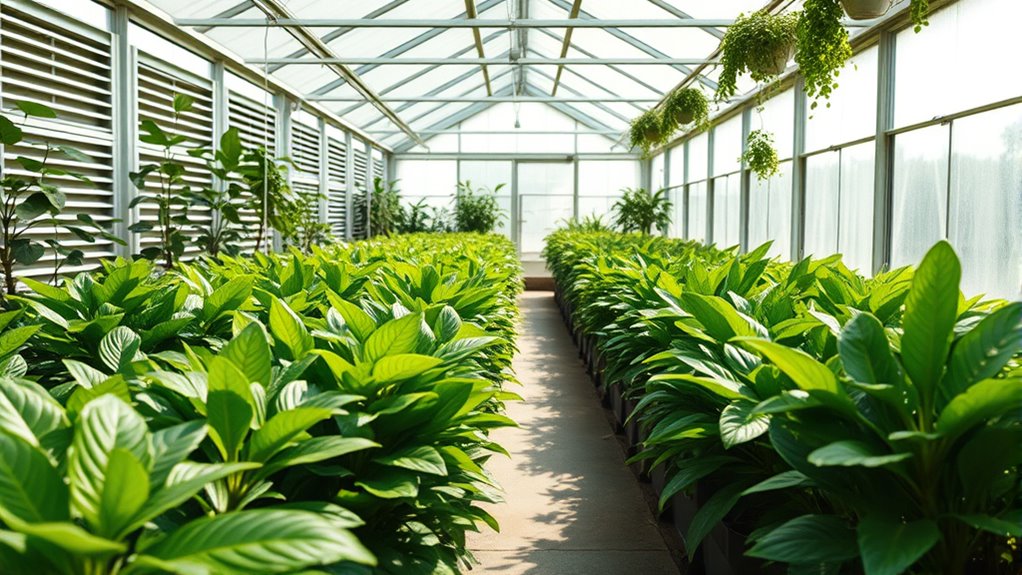
Effective ventilation and air circulation are essential for preventing stagnant air and reducing the risk of disease in your greenhouse. Proper air circulation helps maintain consistent temperatures and humidity levels, promoting healthy plant growth. Use ventilation systems like exhaust fans, vents, and windows to ensure fresh air flows continuously. Consider the layout of your greenhouse to optimize airflow, avoiding dead spots. Here’s a simple overview:
| Ventilation Method | Benefits | Best Use |
|---|---|---|
| Exhaust Fans | Remove hot, stale air | During peak heat |
| Windows/Vents | Promote natural airflow | Daily circulation |
| Circulation Fans | Improve air movement inside | Small or high humidity areas |
Implementing these methods keeps the environment fresh, supporting vigorous plant health. Additionally, understanding airflow patterns can help you design an effective ventilation strategy, which is crucial for maintaining optimal climate conditions within your greenhouse. Regularly inspecting and maintaining ventilation equipment ensures continued efficiency and longevity of your ventilation system.
Pest and Disease Prevention
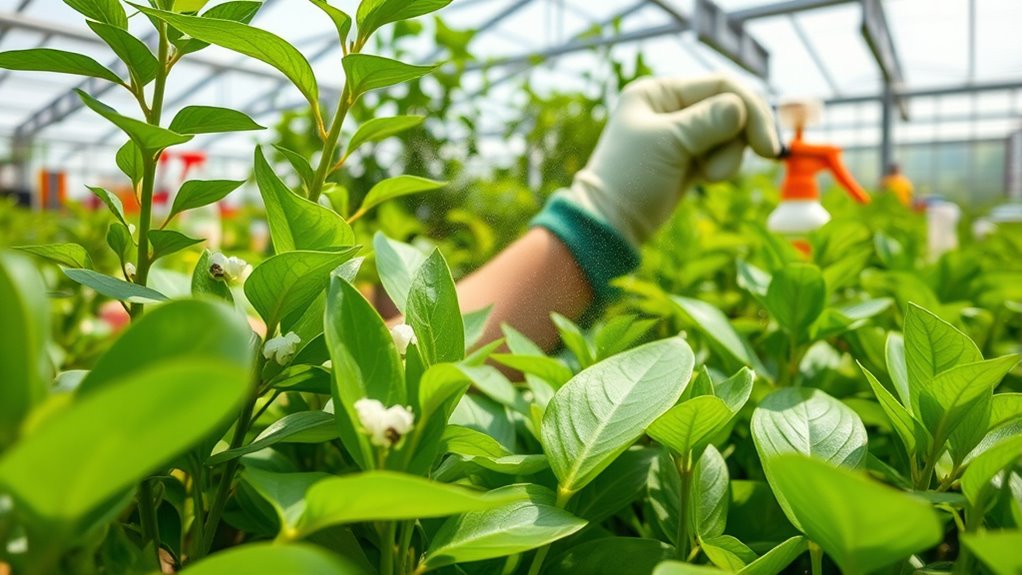
Good airflow in your greenhouse helps prevent the buildup of humidity and stagnant air, which can invite pests and foster diseases. To strengthen pest and disease prevention, consider incorporating biological controls like beneficial insects that target common pests naturally. These controls reduce reliance on chemicals and keep your plants healthy.
Additionally, practice crop rotation by changing plant locations each season; this disrupts pest and disease life cycles, making infestations less likely to develop. Keep debris and dead plant material cleaned up, as they serve as breeding grounds for pests and pathogens. Regularly inspecting your plants allows early detection of issues, but prevention through proper airflow, biological controls, crop rotation, and understanding the benefits of early detection is your best defense against pests and diseases in your greenhouse.
Implementing proper sanitation routines also minimizes the risk of spreading infections, and understanding asset division laws can help you manage your resources effectively, keeping your plants healthier overall. Employing somatic awareness techniques can also help you notice subtle changes in plant health, enabling quicker responses to potential problems.
Regular Monitoring and Plant Care
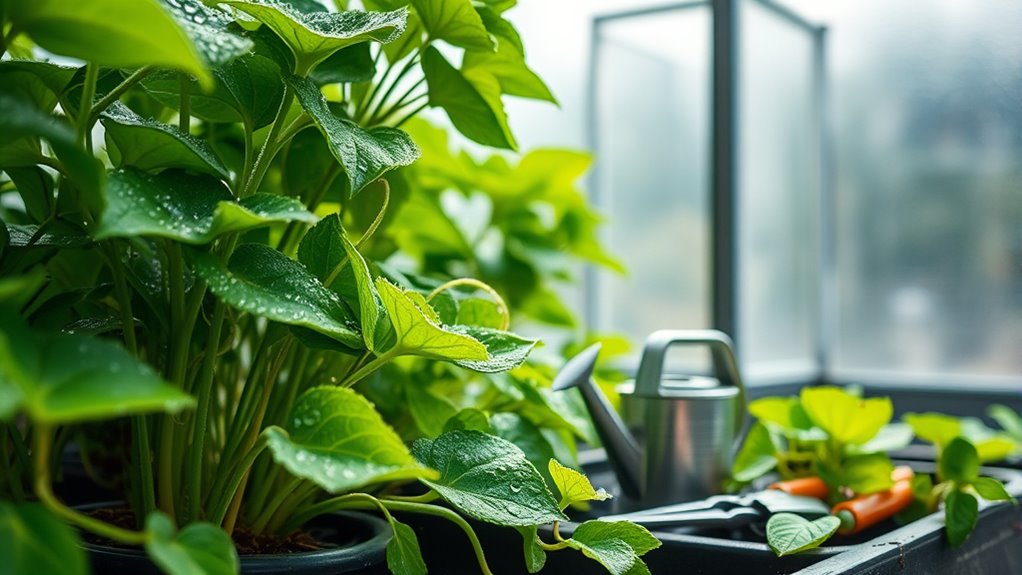
Regular monitoring is vital to catch problems early and keep your greenhouse plants healthy. By routinely checking soil testing results, you can determine if your plants need specific nutrients or adjustments.
Regular monitoring helps identify issues early and maintain healthy greenhouse plants.
Regularly inspecting leaves, stems, and roots helps identify issues like pests, disease, or nutrient deficiencies before they escalate. Proper fertilizer scheduling is also essential; applying nutrients at the right times ensures your plants grow strong and vibrant.
Keep a schedule for fertilization, adjusting based on plant growth stages and soil test outcomes. Consistent observation allows you to respond quickly, whether that means watering more frequently, adjusting light, or applying treatments.
Additionally, understanding plant nutrition requirements can help you make informed decisions about amendments and supplements. Staying vigilant minimizes problems, promotes healthy growth, and keeps your greenhouse thriving.
Frequently Asked Questions
How Do I Select the Best Soil Mix for My Greenhouse Plants?
To select the best soil mix for your greenhouse plants, start by considering their specific needs.
Use soil amendments like compost or peat moss to improve fertility and drainage.
Test the pH level and aim for balanced pH, adjusting with lime or sulfur as needed.
Choose a mix that provides good aeration, moisture retention, and nutrients, creating an ideal environment for healthy growth.
What Are the Signs of Nutrient Deficiencies in Greenhouse Plants?
You’ll notice fertilizer deficiencies through signs like leaf discoloration, which can range from yellowing to browning. If your greenhouse plants show stunted growth or weak stems, it’s a sign they lack essential nutrients.
Keep an eye out for these symptoms, and adjust your fertilization schedule accordingly. Proper feeding helps prevent deficiencies and keeps your plants healthy, vibrant, and thriving.
Regular observation is key to catching issues early.
How Can I Automate Watering and Climate Control Systems?
You can automate watering and climate control systems in your greenhouse easily. Install automated watering systems with timers or soil moisture sensors to guarantee plants get the right amount of water.
For climate control, use thermostats, humidistats, and fans connected to a centralized system to maintain ideal conditions. These setups save you time, reduce errors, and keep your plants healthy by providing consistent, precise care.
Which Plant Varieties Thrive Best in Greenhouse Environments?
Did you know that tropical favorites and succulents thrive exceptionally well in greenhouse environments? You’ll find that plants like orchids, ferns, and bromeliads flourish under controlled humidity and temperature.
Succulents also love greenhouse conditions, as they prefer warmth and bright light. By selecting these plant varieties, you guarantee a vibrant, thriving greenhouse.
Your plants will reward you with lush growth, making your greenhouse a stunning, lush oasis.
How Do I Propagate New Plants From Cuttings or Seeds?
To propagate new plants, start by selecting healthy cuttings or seeds.
For cuttings, plant them in well-draining soil and keep the environment humid. Use plant pruning techniques to encourage root growth, and regularly monitor for pests to prevent infestations.
For seeds, sow them at the right depth and keep the soil moist.
Consistent care guarantees your new plants thrive and grow strong in your greenhouse.
Conclusion
Just like a gardener tending to a delicate bloom, your attentive care keeps your greenhouse thriving. By mastering watering, temperature, ventilation, and pest control, you’re channeling the wisdom of those who’ve nurtured nature’s treasures for centuries. Remember, each small effort plants the seeds for lush growth and vibrant health. Stay vigilant and patient—your greenhouse’s story unfolds with each mindful action, echoing the timeless dance between nurture and nature.
